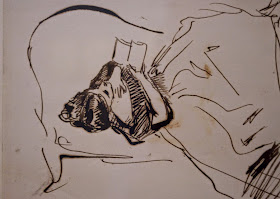Last May John and I visited Tate Britain at Millbank on the Thames. Do you know the two Tate museums? Since the opening of Tate Modern, Tate Britain's collection includes only British artists.
The galleries surround a central courtyard and range from Elizabethan painting to Contemporary art.
The splendid collection of William Blake's work remains a major element of the collection.
Allan Ramsay's Portrait of Thomas, 2nd Baron Mansel of Margam with his Blackwood Half-Brothers and Sister, 1742. Quite a mouthful!
I love the series Four from Samuel Richardsons's "Pamela", 1742, by Joseph Highmore. The picture at the top left has often graced covers to paperback copies of Richardson's novel.
John likes my shot of these long-haired visitors in conversation.
The Victorian Brits seemed to favour a big, sprawling, jolly picture like Benjamin Hayden's Punch or May Day, 1829.
Personally I enjoy the more aesthetic approach in the period. Here's Whistler's Harmony in Grey and Green: Misss Cicely Alexander (1872-4) and The Sluggard (1885) by Frederic Leighton.
Tate Britain has a cornucopia of similar Victorian work.
Oh, and how about this delightful little study by John Constable, Deham from Langham, c1813. Perfect for our library at home!
or perhaps JMW Turner's fabulous Interior of a Great House: The Drawing Room, East Cowes Castle, c1830, would be a better choice. So many decorating decisions!
The Drawings and Prints galleries are always worth a visit. JMW Turner, Blacksmith's Shop, c.1824.
Charles Martin (1812 0r 20-1906). Study of a Woman Reading (detail).
I'm always surprised by the size of Stanley Spencer's The Resurrection, Clapham, 1924-27. Must just be used to seeing his work in books.
When these ladies caught me shooting Jacob Epstein's alabaster Jacob and the Angel (c1940), they tried to duck out of the picture and much improved the shot, I think.
The Mid-century galleries are great fun.
John loved Barbara Hepworth's Three Forms, 1935.
Twentieth century religious art - Arnold Machin's St John the Baptist, c1949.
So cool that the Tate has one of Francis Bacon's early pieces when he was designing furniture - Painted Screen, c1929.
Of course, Francis Bacon's work is well represented in the Tate Britain collection, including Three Studies for Figures at the Base of a Crucifixion, c1944,
and Triptch--August 1972.
It was fun to see David Hockney's The Bigger Splash, 1967.
John couldn't resist a detail.
Let's end our visit with this lovely Howard Hodgkin painting Clean Sheets, 1979-84.
and one of John's found abstractions. Art is everywhere, eh?
We slipped down to the cafe for a drink, past the stairwell piece by David Tremlett,
Drawing for Free Thinking, 2011.

Pastel pigment and Emulsion paint.
One last glance up at Henry Clarke Fehr's oversized Perseus rescuing Andromeda (1873) as we headed off to find lunch. Great Britain, indeed!


















































